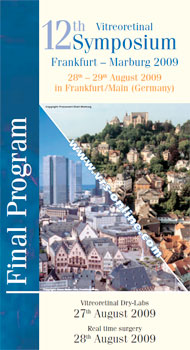12th Vitreoretinal Symposium Frankfurt – Marburg 2009
Scientific programm: Abstract
3rd scientific session: Age Related Macular Degeneration
19. Effects of Combined - vs. Monotherapy
in CNV-induced Albino Rabbits
 Thea Herbort1, M. J. Koss1, S. Julien2, M. Pfister1, T. J. Choragiewicz3, M Pietras3, S Cisiecki4, P. Grieb3, U. Schraermeyer2, R. Rejdak3
Thea Herbort1, M. J. Koss1, S. Julien2, M. Pfister1, T. J. Choragiewicz3, M Pietras3, S Cisiecki4, P. Grieb3, U. Schraermeyer2, R. Rejdak3
(1Frankfurt/Main; 2Tübingen; 3Lublin; 4Lodz)
Purpose: To determine the change of intraocular oxygen tension and growth factors in Vector-induced CNV albino rabbits after anti-VEGF combined- vs monotherapy regimen.
Methods: Vascular endothelial growth factor (VEGF-A) delivered by a high capacity adenoviral vector (HC Ad. VEGF-A) was injected at 5x106 infectious units (iu) subretinally into 10 (+ n 0 2 control) rabbit eyes (T0). One week postinjection (T1), the eyes were treated with 1.25mg bevacizumab (group I; n=6 eyes), core pars plana vitrectomy (cppV) 0,5ml + bevacizumab + 800µg dexamthasone (group II; n=4 eyes) and cppV 4ml+ 4ml BSS + bevacizumab + dexamethasone (group III; n=6 eyes). The development of CNV was evaluated by fluorescein angiographies, optical coherence tomography (OCT), and intravitreal VEGF and MCP levels at T1 and T2 (two weeks postinjection). The intravitreal oxygen tension was assessed by a fiber optic oxygen system in the central vitreous (CV), preretinally (PR), and adjacent to the optic disc (OD).
Results: At T1 CNV with leakage was found in 50% of the rabbit eyes. At T2 no leakage could be detected in group I-III, which was analyzed by immuno-histology. The oxygen tension in CV changed significantly (p<0.05) from T1 to T2 in group III, which was also significantly different (p<0.05) versus group I regarding PR. At OD group III achieved a significantly higher oxygen tension at T2 versus group I. VEGF and MCP was 7.2, 1.1 (group II) and 19.6, 3.4pg/nl (group III) at T1, which was undetectable at T2 (group III p<0.1); group I had 5.5 and 1.5pg/nl at T2.
Conclusion: All applied therapies show potential concerning the treatment of leaking CNV in this animal model. The 4ml cppV led to changes of intraocular oxygen which might enhance the pharmacologic synergism of the combined therapy to counteract CNV development and progression.
Copyright © VRS-online, 1999-.
All rights reserved. Impressum, rechtliche Hinweise
HTML & Webdesign: SPALLEK.COM
